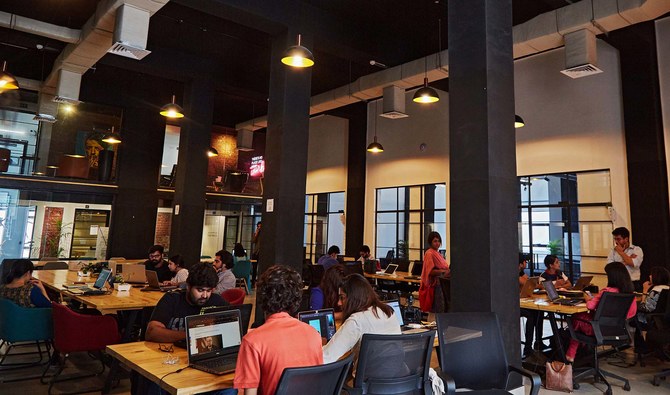The Covid-19 pandemic has brought about several changes and taught the corporate world many valuable lessons. Many employers have now realized that working from home is not a bad thing. Pakistani employers are more comfortable with the concept after being forced to use it.
Work can be finished on time, and productivity can be maintained. Similarly, many employees who wish for it earlier have realized that working from home has drawbacks. Among the benefits of the hybrid work model is its cost savings for both employers and employees. This holds particular merit in light of the growing fuel prices, which make commuting a financial challenge.
The Hybrid Workplace Model
A hybrid workplace is a working system where some employees work from the office while others work remotely, supported by technology. Modern communication options like video calls, online meetings, document sharing, and a suite of collaboration apps enable geographically-distributed teams to function and succeed
How to Design an Effective Hybrid Model
The first step in developing a hybrid work model is to identify (and own) the objectives behind going for it. Once the goals are clear, the critical success factors and the significant challenges should emerge dynamically. This should crystalize the entire process so that dissenters and supporters know why they are opting for the hybrid model in the first place. The last step is to have measurable and transparent metrics to measure success.
Critical Objectives in Designing A Hybrid Workplace
When executing a significant transformation, it is easy to lose sight of the end goal. Remembering the factors behind the decision should help everyone stay on track.
Hybrid workplaces are based on striking the right balance. While workplaces set out to develop a flexible and hybrid workplace by allowing employees to work remotely, the information security risks increase. Managers need to budget for better security and privacy infrastructure at the planning stage.
This means ensuring that you have adequate IT resources and trained staff while or before transforming into a hybrid workplace.
Common Challenges In Designing A Hybrid Workplace
There are some challenges with implementing a hybrid work model. Opting for the hybrid work model may not be ideal, but it is necessary for many businesses. Many businesses implemented the hybrid model during the pandemic and now expect to continue with it due to the advantages it offers. However, things have evolved from that time, and policies should be more forward-looking.
This means that revised work metrics for appraisals and promotions must be implemented.
Counting work hours, evaluating employees on the promptness of their response, or frequency of response on Slack or Teams is a reimplementation of old parameters in an obsolete work environment. Clarify work objectives and communicate your expectations in terms of productivity
One of the most common challenges is the inability to realize that you have two groups of employees working in different situations. It is easy to get irritated over delays caused due to remote work, especially when you make the mistake of not having different benchmarks between people working from their homes and those working in a distraction-free environment equipped with adequate infrastructure.
All of these issues need to be incorporated into revised work policies and communicated to managers and employees, so they know what they are getting into.
Mindset Changes needed In A Hybrid Workplace
In a hybrid workplace, employee management revolves around productivity and not just attendance. Most organizations, which have already allowed remote work pre-Covid, have policies for it. But hybrid workplace policies are different. It isn’t the case of a few employees working from home for a few days. A significant part of your employee team would be contributing remotely for a prolonged duration, while another group will work on-site.
Given the different work environments, using the same measures of performance, or indicators of the engagement level, may lead to unequal treatment. Measuring output in a certain number of work hours might unfavourably tilt the balance towards people working from the office
Most of us rely on visual observations to see if teams are working. It’s also easier to set up performance parameters and follow up in a physical workplace. In a hybrid setup, the approach needs to change. In a virtual environment, managers need to use technology to use a more empathetic and supportive approach to ensure their teams remain productive.
Communicating guidelines and policies and keeping in touch with your team helps businesses implement the hybrid work model.
Implementing a Hybrid Workplace
Like any new initiative, managers need to develop an employee buy-in for implementing a hybrid workplace model. The following steps should help in going about it:
- Listening to employee concerns and including them from the start and all through the planning process will help to avoid any setbacks. Have your employee surveyed for feedback and opinions, document the data, and maintain transparency throughout the process.
- Guidelines for WFH are naturally different from those for a hybrid workplace. You can develop a comprehensive yet easy set of guidelines by thinking through various situations and cases. List the pros and cons clearly, with no space for neutrality. Also, strive to establish an even playfield for employees working remotely.
- Communicate with your employees: A sudden change may be upsetting. Hence, employers should communicate the reasons behind opting for a hybrid workplace model. When starting the plan, back it up with data and the benefits both for the business and the employees.
Measuring Hybrid Workplace Success
Every transformation process is based on an objective. Evaluate the success against those objectives. Following are the basic steps to measure the success of your hybrid workplace model:
- Identify a baseline to measure results: If the goal is to increase productivity, decrease lost opportunity, or human error costs caused by remote work – quantify your baseline figures to continue, stop or amend.
- The KPIs related to digital transformation also apply to hybrid workplaces. These can be technology cost per employee, workplace & technology utilization rates. Human resource management can be another dimension for your KPIs – attrition rates, employee satisfaction, etc.
- Incorporate qualitative insights: As the workplace amends to the hybrid workplace, all stakeholders undergo a substantial change, which may not be reflected accurately in numbers. Incorporating behavioural insights and anecdotal evidence may prove helpful in the long term.

Sadia Zaheer holds a Masters in Business Administration from IBA, Karachi. After working in several financial institutions in Client Management, Corporate Lending, Islamic Banking and Product Management she jumped careers to pursue a career in writing.
She is a Finance, Business and HR Development writer with four years of experience. She reads a lot and takes care of her multiple cats to remain calm.



